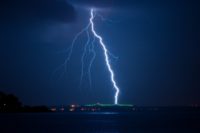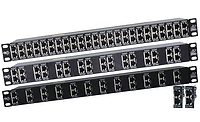When is the last time your facility was subjected to an electrical power surge? Chances are, you have no idea – for two very good reasons. First, power surges are typically very brief – lasting only a few milliseconds. Secondly, most power surges are relatively small and go unnoticed, unless they are significant enough to make the lights flicker. Even so, they remain dangerous to your systems and should not be ignored – they are a silent killer of your critical electronic equipment.
Power surges and spikes fall into two categories: impulsive surges and oscillatory surges. Impulsive surges are usually caused by atmospheric discharges, such as a lightning strike, though they can also be caused by accidental contact with power cables, short circuits and similar causes. Impulsive surges can cause almost immediate and total failure of sensitive electronics and alarm systems. The second type is oscillatory, caused by utility grid switching and inductive loads nearby, or often within a facility’s electrical system. An inductive load includes large electric motors switching on and off such as HVAC systems, or refrigeration equipment and pumps, which are items that are found in many facilities. Oscillatory surges can deteriorate sensitive circuitry over an extended period of time, eventually destroying them. Power spikes can also enter data/telecom lines such as phone and computer networks just as easily as they can travel along electric power lines.
The result of both types of surges and spikes is the same: damaged and/or destroyed equipment and costly downtime. When security or fire systems are out of service, facilities may have to be evacuated. Secure areas may need to be covered by temporary security officers at an extra cost. There is also a loss of productivity if staff is delayed because their work equipment and/or work data is damaged or lost. Downtime can also cause a potential loss of customer confidence or business. Many businesses expect insurance to cover damaged equipment, but the other losses may actually be more damaging in the long run.
For example, in one instance, a power surge forced an unprotected Orlando resort to maintain a “fire watch”, meaning a fire truck was stationed in their main parking area 24/7. The final price tag of the damage was $320,000 and 17 days of interrupted operations. An $8,000 investment in surge protection on the resort’s fire alarm, power and network systems would have kept this from happening.
In another example, a newly-installed access control system at an airport located in the Southeastern United States experienced card reader failures shortly after the system was installed. The problem was dry air that created electrostatic discharge (ESD), damaging the internal circuitry and causing controlled doors to malfunction. Eventually the access control system suffered a major surge event, causing card reader and mag lock failures. Door solenoids failed, and the entry/egress doors in secured areas would not open. The overall physical security of the airport was compromised for a period of time. Surge protection was added to each controlled door panel and the system has since suffered no further reports of malfunction or damage.
Any enterprise, from schools to airports and retail to hospitality sectors, can benefit from surge protection, because every enterprise depends on electronic systems at some level, for security or for supporting functional operations. What enterprise doesn’t use any kind of access control system, surveillance system, POS system, phone system or IT system?
All of these potential downsides are straightforwardly addressed by installing appropriate surge protection devices, or SPDs. The modest cost of these devices only enhances the enormous service they provide – literally keeping your organization and critical equipment up and running at all times! Ideally, every important electronic system should be protected by SPDs during installation; however, it can easily and cost-effectively be added to existing systems to provide immediate protection.
There are surge protectors designed for a wide range of applications, from fire alarms to IP networks to HVAC systems and more. At the lowest price points, surge protectors absorb the excess energy on the line to save the protected systems. Higher quality devices can absorb multiple hits and remain operational. Some surge protection devices even have the capability to alert operations staff that they have performed their function and may need to be checked or replaced to maintain protection.
Don’t let your critical electronic systems go unprotected from this silent killer – take action to check your current status. If protection is missing, take steps to add SPDs on all critical system and demand that every new system and/or upgrade proposal includes surge protection to help ensure the highest system reliability and equipment life.
No security system or location is immune from power surges – remember that many surges are created within the facility. Surge protection needs to be an integral element of every life safety and security system – demand it.







